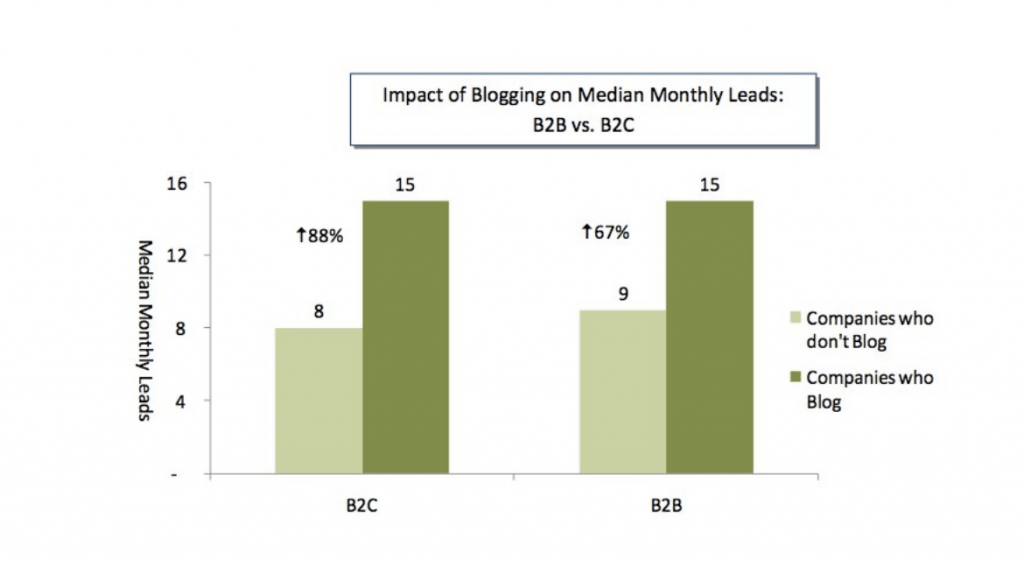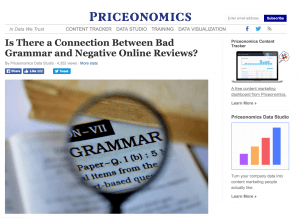Business blogging has become one of the most essential methods for connecting with customers and building your website’s SEO authority. And a number of studies have confirmed the value of business blogging: it results in 55% more traffic, 97% more inbound links, and 67% more leads.


By pretty much every measure businesses use to determine website success, having a business blog is one of the best paths to improved results.
But consistently maintaining a business blog is time consuming and costly—especially one where you only publish blog posts that provide real value to your audience. And if you’re not doing that, what’s the point?
If you’re going to invest in a blog for your business, you need it to get results. And that requires the right approach. Here are a few good ways to make your business blogging go further.
1. Start with a business blogging strategy.
You know you’re supposed to blog, so it can be tempting to just start getting blog posts up to check that box. But if you want your business blog to help you accomplish anything substantial, you need a business blogging strategy.
This should involve a few main steps:
- Define your goals.
You’re investing time and money into your business blog because you want it to do something tangible for your business. In order to build your strategy around the things you want to accomplish, you need to clarify what your goals are. Write your goals down and, as much as possible, figure out specific metrics you can track to measure your progress. Measuring a goal like “establishing thought leadership” will be trickier than something like “increasing traffic,” but do your best.
And make sure you stay realistic here. If your goal is a number one ranking for every target keyword, or publishing a blog post every day with a team of two people—you’re setting up yourself up for failure. Keep your goals within reason.
- Do audience research.
Your blog isn’t for you. And while it is for your business—in the sense that it’s meant to help you forward your business goals—you’re better off thinking about it as something you do for your audience first and foremost. To deliver content that your audience will value and appreciate, you need to take some time to understand who they are.
Audience research can involve a mix of data analysis—both of demographic data and marketing analytics—as well as getting more direct input from your audience using surveys or interviews.
- Do keyword research.
Keyword research is valuable on a number of levels.. It helps you get a read on the topics your audience is talking about and the language they use. It can be a fruitful source for coming up with topics to cover on your blog. And it’s an important part of any SEO strategy, so you know what keywords to optimize each piece of content for.
- Spend time studying up on good business blogging examples.
You’re not starting from scratch here. If you already have a blog, analyze your most successful posts to gain a better understanding of what works well for you now. Even if you’re just starting a new blog, you can look to examples of successful blogs in your topic area to see what your audience responds well to. By taking the time to research successful business blogging examples, you’ll take some of the guesswork out of building your strategy.
2. Keep SEO top of mind.
One of the best things about business blogging is the bump it can give to your SEO rankings. It gives you more opportunities to cover relevant keywords and topic areas, so you show up for more searches. If you provide valuable information in your posts, it gives other websites more reasons to link back to you. And some of the on-site ranking factors Google values, like time spent on site, are helped by having blogs that keep people around.
Just by having a business blog, you’re vastly improving your SEO chances. But you can help your blog posts do better in the search engines by taking a few extra steps to give your blog posts an extra SEO edge:
- Do SERP research.
Before every blog you write or assign, take a minute to do a Google search for the keyword you’re hoping to rank for. See what type of content has made the first page for this topic. Seeing the current results offers insights into what works for that term in the search engines. Are the top results short and to the point, or are they long and comprehensive? And most importantly, what opportunities can you see to improve upon the information provided in those top posts?
- Consider featured snippets.
A natural consequence to doing SERP research is starting to see when and how Google uses featured snippets in the results. When the search includes an answer box, write your blog post in a way that optimizes your chances for taking that answer box. The best way to do that will depend on the type of featured snippet that shows up in the search: a list snippet, a chart, or a brief text answer. Pay attention to the type of rich results on the SERP for your target term so you can create content more likely to win position zero.

- Strategically use headings.
Dividing your blog posts into sections with headings is good for both readability and SEO. It makes it easier for your visitors to skim to find the information they need, and it gives you more chances to signal to Google what your content is about. Use your target keywords in your headings where it’s relevant to do so (but don’t overdo it—it still has to be useful for your human readers).
Customize all relevant fields.
This is a simple step that can make a big difference in SEO. Make sure you customize your page URL, title tag, meta description, and alt image text to include your target keyword for a blog post. It’s a small but important way to emphasize what your post is about in a way the search algorithms recognize. If you use WordPress, any good SEO plugin you download will make this easy to do.
3. Use your blog to answer common questions.
One of the best sources for coming up with blog topics your audience will find useful is going straight to the source. What are the questions your your customers and prospects most often come to you with? Review old emails and talk to your sales and customer service representatives to work up a list of the most frequent questions you get.
When you write blog posts that answer common questions, you accomplish two things at once. First, you write content that you know, without a doubt, your customers are interested in. And second, you make the lives of your sales and customer support teams easier, since they’ll now have handy resources they can share each time they get those questions in the future.
Your blog becomes a sales enablement and customer service tool, as well as a marketing one.
4. Commit time to quality.
I know. This one is hard. You’re busy. Your team is probably already overwhelmed. And blogging brings the pressure of publishing a lot of content. A higher frequency of posts tends to mean better results in terms of traffic and lead gen. But rushing your content means you risk publishing stuff that’s not very good. And none of the benefits of business blogging come into play if your content sucks.
Make sure you’re willing to commit the time and resources needed to make every blog post worth it. And if you’re not sure your current team is up for the task, hire a good freelance blog writer to help pick up the slack.
5. Create a plan for promotion.
Publishing an amazing blog post isn’t good enough. The internet is simply too saturated for your audience to find you on their own. You need to do everything you can to get your awesome blog posts in front of them.
As part of your blog strategy, create a plan for promoting your blog posts. This can include:
- Sharing the links on social media.
- Nurturing relationships on social media (so your feeds aren’t just promotional).
- Writing guest posts on relevant blogs that link back to your best posts.
- Collaborating with influencers on your blog posts, so they’re more likely to share them with their networks.
- Paid distribution methods, such as search and social ads.
Investing in content promotion is as important as investing in high-quality content creation. If you want your business blogging to go further, you can’t skip this step,
6. Regularly review your analytics.
The first step to doing better is understanding how you’re doing now. With business blogging, that means making it a habit to check your website analytics regularly to gauge the success of your blog posts. Google Analytics provides extensive data on how many people are viewing your blog posts, how people are finding them, and what they do once they’re on the page.
When you combine Google Analytics with the data from other sources, like your email marketing software and customer data, you can also track the role your blog posts play in driving visitors to the actions you want them to take, like signing up for your email list or making a purchase.
Use that data to regularly analyze the success of your blog posts and determine which types of blogging tactics and styles are helping you achieve your primary goals. The more you know what works, the more you can shape your blog strategy to get the results you seek.
7. Perform content audits (at least) annually.
Businesses often get swept up in the flurry of work required to consistently create new content for a blog, but it’s just as important to take a step back and look for ways to get more out of the content you already have. At least once a year, perform a content audit to find opportunities to make your old blog posts better.
You’ll find blog posts that can be updated or strengthened, internal linking opportunities that can drive more visits to other posts, and spot any errors or broken links that need to be fixed. Content audits can help you get more traction from old posts, spur ideas for new posts you can create, and help you ensure every piece on your blog represents your brand at the level you want it to.
8. Make a habit out of updating and repurposing.
The longer you have a blog, the more content you’ll have that falls out of date or becomes forgotten. The work you did on a great blog post five years ago will cease to matter if you stop there. Instead, make sure you revisit your old content regularly to find ways to update it and make it better.
In addition, you can make the work you did in the past go further by repurposing your most successful blog posts into new formats. Your top blog post could become a highly valuable video series or webinar. You already know your audience values the information you provided, so give them more ways to interact with it in the format of their choice.
Build a Better Business Blog
Your business blog is only valuable if your audience finds it, reads it, and comes to care about your brand because of it. Without the right strategy and approach, your blog posts will just be one more thing crowding the web without purpose.
If you struggle to consistently create business blog posts that your audience cares about, a good freelance blogger can help. Get in touch to see if we’re a fit.




 Media Bistro helps play matchmaker for hiring managers in the media industry and the talented professionals they hire. Since the company has two equally important audiences, they produce two blogs:
Media Bistro helps play matchmaker for hiring managers in the media industry and the talented professionals they hire. Since the company has two equally important audiences, they produce two blogs: 




 visible and reaching customers on the web. But a lot of people doing it are struggling to see the kind of results they want.
visible and reaching customers on the web. But a lot of people doing it are struggling to see the kind of results they want.